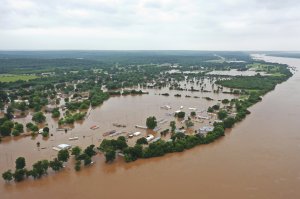FORT SMITH, Ark. — Brad Hindley planned to be vacationing on a lake this week. Instead, he’s been on a boat in his swamped Fort Smith neighborhood trying to keep gas in generators that are pumping water from his flooded home in Arkansas’ second largest city.
“We’ve got lakefront property now. Right up to the front door,” said Hindley, a 45-year-old FedEx worker who is among thousands of residents along the Arkansas-Oklahoma border impacted by widespread flooding along the swollen Arkansas River.
Heavy rainfall on Wednesday has intensified flooding in the already saturated region, where the river has hit record water levels. Officials said an aging levee system was holding up despite a rush of water coming downstream from rain-soaked Oklahoma and Kansas.
Still, the river was nearly twice the level it was 10 days ago and flash-flood warnings were issued across the region Wednesday.
“Just because the river has crested doesn’t mean we’re out of danger,” said Col. Bob Dixon of the U.S. Army Corps of Engineers.
Hindley and his family began piling sandbags around their home Friday. By Sunday, Hindley and his wife Wendy, along with their three children, had to evacuate to his father’s home, which wasn’t expected to flood.
“We sandbagged for two days in vain. The water found its way in,” said Bart Hindley, 71.

Brad Hindley said his house is in a 500-year flood plain, meaning the chances of flooding were so remote that he didn’t obtain flood insurance. Now, he said he’s not sure what his family will do when the waters recede.
“Get a big loan. Start over,” his father suggested, as another round of heavy rain began.
“It’s overwhelming because you can’t do anything. The water had the power,” the elder Hindley added. “You can’t block water. It’s coming whether you do stuff or not.”
Brad Hindley agreed: “We’re handcuffed,” he said.
Officials said hundreds of homes could flood in Fort Smith. Across the border in Oklahoma’s Muskogee County, the conditions have already prompted the evacuations of more than 2,400 people and flooded nearly 1,100 homes, according to the local emergency management department.
The new rain was expected to make matters worse because the excess water has nowhere to drain.
Dixon said the levee system will be strained as the water moves downstream into Arkansas. Record crests are predicted at several sites, and two levees have already been topped in rural areas of Arkansas.
Arkansas Gov. Asa Hutchinson said Wednesday that more than 400 homes have been voluntarily evacuated because of the flooding. The Republican said he directed another $250,000 in state funds toward the flood response and requested federal assistance from the Trump administration. Hutchinson last week directed $100,000 in state funds toward the flood’s response.

Swollen rivers are also causing problems along the Nebraska-Iowa border, where some residents are facing evacuations just weeks after thousands of people in the region were forced from their homes because of flooding.
In Arkansas, Dixon said the water in Fort Smith should soon begin receding, but he said that would likely take weeks. The river was at about 40 feet (12 meters) on Wednesday, breaking the previous record crest of 38 feet (11.5 meters) that was set in 1945.
At least one death has been blamed on the flooding.
“This is a flood of historic magnitude. It surpasses all Arkansas River flooding in our recorded history,” Hutchinson said Wednesday at a news conference with state emergency officials. “That should be enough to get everybody’s attention.”
The rush of water is coming as the Army Corps of Engineers releases water from a hydroelectric dam northwest of Tulsa, Oklahoma, to help drain the swollen Keystone Lake reservoir. The reservoir drains a watershed of more than 22,000 square miles (57,000 square kilometers) in areas of northeastern Oklahoma and southeastern Kansas that have been hit by heavy rain.
The water is being released from the reservoir at 275,000 cubic feet per second (7,787 cubic meters), roughly the amount of water needed to fill three Olympic-sized swimming pools.
The Corps said Wednesday that the releases would be reduced by Saturday to 150,000 cubic feet per second (4247 cubic meters). The release is necessary to prevent the reservoir from spilling over and enabling floodwaters to flow uncontrolled down the river, according to Preston Chasteen, spokesman for the Corps’ Tulsa District.
“If these dams weren’t in place to control these releases, I think the circumstances would be far worse than they currently are,” he said Tuesday.





















